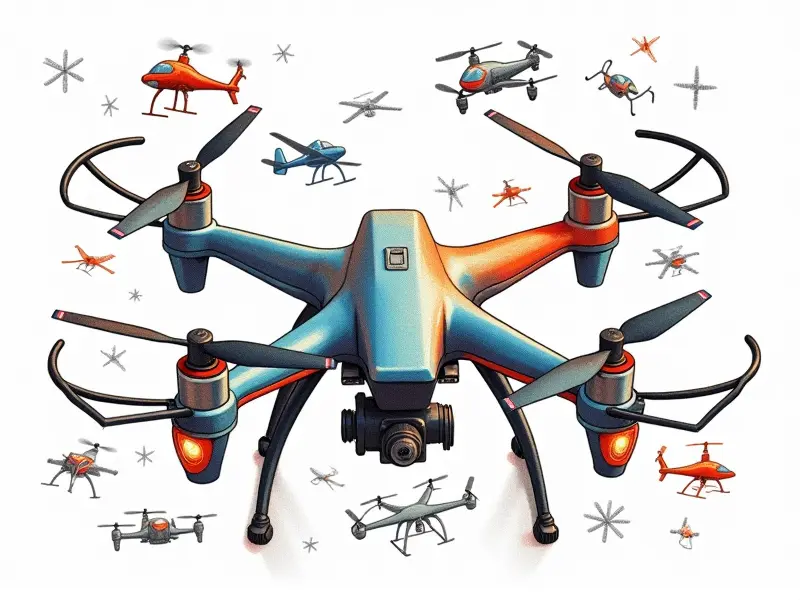RC airplane motors explained

Understanding RC Airplane Motors Basics
Radio-controlled (RC) airplane motors are the heart of any RC aircraft, providing the necessary thrust to achieve flight. These motors come in various types and specifications, each designed for specific performance characteristics such as power output, efficiency, and durability.
Top Motors for RC Planes Explained
When it comes to selecting a motor for your RC plane, there are several top contenders that stand out due to their reliability and performance. Here are some of the best options available in the market:
- Bell 5015-6 Brushless Outrunner Motor: Known for its high torque and efficiency, this motor is ideal for large-scale RC planes.
- Turnigy SK3 2837 3000KV Brushless Outrunner Motor: This motor offers excellent power-to-weight ratio and is suitable for smaller to mid-sized planes.
- T-Motor F55 Brushless Inrunner Motor: Designed for high-performance applications, this motor provides exceptional speed and precision control.
How to Choose the Perfect RC Plane Motor
Selecting the right motor is crucial for achieving optimal performance from your RC plane. Here are some key factors to consider:
- Motor Type: Decide between brushless outrunner and inrunner motors based on your specific needs.
- KV Rating: The KV rating indicates the motor's RPM per volt, which affects speed and torque. Higher KV ratings are suitable for smaller planes with propellers of lower pitch.
- Power Requirements: Consider the power requirements of your plane to ensure that the motor can deliver sufficient thrust.
- Battery Compatibility: Ensure that the motor is compatible with the battery pack you intend to use, considering voltage and current draw.
- Durability: Choose a motor that can withstand the rigors of frequent flights without compromising performance or longevity.
RC Airplane Motors: A Comprehensive Guide
This guide delves into the intricacies of RC airplane motors, covering everything from basic principles to advanced selection criteria. Understanding these concepts will help you make an informed decision when choosing a motor for your RC plane.
Motor Specifications
- Stall Torque and RPM: These specifications indicate the motor's performance at maximum load and no-load conditions, respectively.
- No-Load Current Draw: This measures how much current the motor consumes when running idle.
- Power Output: The power output of a motor is crucial for determining its suitability for different types of planes.
Motor Efficiency
The efficiency of an RC airplane motor directly impacts flight performance and battery life. Higher efficiency means better use of the available energy, leading to longer flight times and improved overall performance.
Essential Tips for RC Airplane Motor Selection
To help you make a well-informed decision when selecting an RC plane motor, here are some essential tips:
- Match the Motor to Your Plane's Design: Ensure that the motor is compatible with your aircraft’s design and intended flight characteristics.
- Consider Propeller Compatibility: The propeller you choose should be compatible with the motor, balancing thrust and efficiency.
- Test Before Committing: If possible, test different motors to see which one performs best for your specific application.
The Ultimate Guide to RC Airplane Propulsion
This guide provides a detailed overview of how RC airplane propulsion works and the various factors that influence motor performance. Understanding these principles will help you optimize your RC plane's flight capabilities.
Propeller Dynamics
- Pitch vs. Diameter: The pitch and diameter of the propeller affect thrust and efficiency differently, impacting overall performance.
- Aerodynamic Design: Propellers with optimized aerodynamics can significantly enhance motor efficiency and flight duration.
Motor-Propeller Matching
Selecting a propeller that matches your motor's characteristics is crucial for achieving optimal performance. Proper matching ensures maximum thrust while minimizing power consumption.
Mastering RC Airplane Motor Efficiency
Maintaining high efficiency in your RC airplane motor is key to extending flight time and enhancing overall performance. Here are some tips to help you achieve this:
- Regular Maintenance: Keep the motor clean and well-maintained to ensure it operates at peak efficiency.
- Optimize Propeller Design: Use propellers that are specifically designed for your motor's KV rating and power output.
- Battery Management: Proper battery management can significantly impact motor performance and longevity.
RC Plane Motors Explained Simply
If you're new to RC flying, understanding the basics of motors is essential. This section provides a straightforward explanation of what RC airplane motors are and how they work:
- Motor Types: Brushless outrunner and inrunner motors explained.
- Functionality: How these motors generate thrust to propel the aircraft.
- Voltage and Current: Understanding how voltage and current affect motor performance.
Common Mistakes in RC Motor Selection
Avoiding common pitfalls is crucial when selecting an RC plane motor. Here are some mistakes to watch out for:
- Mismatched Components: Using incompatible motors and propellers can lead to poor performance.
- Ignoring Efficiency: Overlooking the importance of efficiency can result in shorter flight times and higher energy consumption.
- Poor Maintenance Practices: Neglecting regular maintenance can reduce motor lifespan and performance.
Beginner's Guide to RC Airplane Motors
This section is designed for beginners who are just starting their journey into the world of RC flying. It covers fundamental concepts and practical advice:
- Understanding Motor Specifications: Learn how to read and interpret motor specifications.
- Selecting the Right Motor: Tips for choosing a suitable motor based on your plane's design and intended use.
- Maintaining Optimal Performance: Strategies for keeping your motor in top condition.
RC Airplane Motor Types Demystified
This section aims to clarify the differences between various types of RC airplane motors, helping you make an informed decision:
- Brushless Outrunner Motors: These motors are known for their high torque and efficiency.
- Brushless Inrunner Motors: Suitable for applications requiring higher RPMs and compact design.
- Comparison of Features: Understanding the pros and cons of each motor type.
By understanding these concepts, you'll be better equipped to choose the right RC airplane motor that meets your specific needs and enhances your flying experience. Happy flying!

